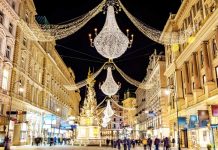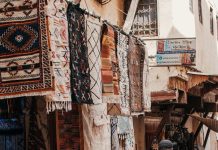It was a route fraught with risk. To reach Mont-Saint-Michel, the island abbey off the coast of Normandy, medieval pilgrims braved quicksand and the strongest tides in continental Europe. Despite these hazards, this pilgrimage route was one of the most trafficked of the Middle Ages.
Since then, travelers continue to flock there, making it France’s most popular site outside of Paris. In 1878, a causeway was built for easier access, which blighted the landscape. Silt carried by the tides accumulated in the bay, encroaching on the island and threatening its very existence.
Yet, as 2023 marks a millennium since the abbey’s construction, the UNESCO World Heritage site has embarked on wide-ranging sustainability initiatives, beginning with the 2015 completion of a massive engineering project to restore the Mont’s maritime character, ensuring its island status.
“Our goal is to guide the renewal of Mont-Saint-Michel,” says Thomas Velter, director of Epic du Mont, the new governing body overseeing the site’s renewal. “The approach is sustainable tourism, better management of the tourist flow, and valorization of the surroundings [and] natural setting.”
Born of a dream
The Mont’s mystical origins begin in A.D. 708. The story goes that the Archangel Michael appeared in the dreams of Saint Aubert, the bishop of nearby Avranches, asking him to build a sanctuary in his name. In the final vision, the Archangel stuck a finger in Aubert’s head, boring a hole in his skull to emphasize his request.
Benedictine monks eventually settled on the site in A.D. 966, and work on the Romanesque abbey began in A.D. 1023, lasting for 60 years. Over time, successive buildings were piled onto the granite, showcasing a “full encyclopedia of medieval architecture through to the Gothic style,” says François Saint-James, an art historian and longtime tour guide.
Nicknamed “the City of Books” for its renowned library, it became a bastion of learning. Monks in the scriptorium copied manuscripts, including bibles and scientific treatises. Only 200 of the estimated 800 manuscripts are preserved today, stored at the Scriptorial Museum in Avranches.
“These manuscripts are the most important objects from Mont-Saint-Michel,” says Bérengère Jéhan, the museum’s director. “They have an immeasurable historical value.”
(These are the world’s most enchanting libraries.)
A long history of tourism
The museum also reveals the tourist infrastructure that developed for the pilgrims at what was considered “the end of the world—facing the sea, where the sun sets,” says Saint-James. Like today’s souvenirs, the miquelots, or pilgrims, bought talismans to remember their journey. “The archaeological discovery of molds [used by village artisans to cast the trinkets] shows there was booming economic activity in the village in the 14th century,” explains Jéhan.
Today the Grande Rue, the main artery through Mont-Saint-Michel, is still lined with shops. But outdoor stalls are no longer allowed in the narrow street, which helps to relieve congestion. Increasingly there’s a focus on quality and local craftsmanship.
Winter bestsellers are wool sweaters by Saint James, the 130-year-old clothing brand that’s classified by the French government as a “Living Heritage Company.” Originally designed as a “second skin” for fishermen, these sweaters require a little over 14 miles of thread, the same distance as between the factory and the Mont. During the holiday season, Epic du Mont opened a pop-up boutique showcasing local products with portraits of the artisans who create them. Soon there will be two such boutiques on site.
(Here’s how tweed became a symbol of Scottish culture.)
Visitors walk around a courtyard at Mont-Saint-Michel. Benedictine monks settled in the abbey in the mid-10th century. Today, monks and nuns from the Monastic Fraternities of Jerusalem continue the religious tradition.
Photograph by Mieneke Andeweg-van Rijn / Alamy
Please be respectful of copyright. Unauthorized use is prohibited.
A double masterpiece of nature and art
Mont-Saint-Michel wouldn’t be what it is without the sea. “It has a magnetic effect on visitors because of its setting, the majesty of the tides, and the changing of the light,” says Sébastien Daligault, a naturalist with Label Nature, who’s been leading bay excursions for more than 20 years. In fact, the UNESCO classification isn’t limited to the abbey—it extends to the surrounding bay.
The natural milieu was at the heart of the 10-year engineering project completed in 2015 to ensure Mont-Saint-Michel’s future as an island. The causeway was destroyed and a dam was built in the Couesnon River to regulate water flow and harness hydraulic power to flush silt out to sea. The parking lot was moved inland to a site that’s connected by a shuttle service. Not only did this beautify the base of the Mont, it also triggered a change in tourism, with visitors forced to linger longer. Gone were the tour buses that ferried tourists on an obligatory daylong grand tour of France.
These efforts helped restore the supertides, which take place about 10 times a year, when the Mont is completely surrounded by water—a much-feted natural phenomenon that hadn’t happened since 1879.
In more recent years, tourism has shifted toward the bay. “There’s been an explosion in the demand for bay crossings,” notes Saint-James, the historian and tour guide. These visitors learn about the region’s flora and fauna while following in the footsteps of the pilgrims who crossed the bay at low tide.
The bay is home to environmental riches as wondrous as the abbey’s artistry. “It’s one of the best birdwatching spots in Europe, with … observed species totaling 356 in 50 years of ornithology here,” says Sébastien Provost, an ornithologist who launched Birding Mont-Saint-Michel just four years ago. Not unlike the world’s tourists that descend on the Mont, Provost notes “the bay is a meeting place for diverse populations of migrating birds,” such as the Brant Goose, which flies from Siberia to winter in the bay.
“Mont-Saint-Michel isn’t just the built heritage; it’s also the natural heritage and landscape,” says Velter.
The Mont’s new millennium
A thousand years after the first stone was laid, the Mont is reinventing its image through slow tourism and promoting surrounding areas. Events such as theater shows at the Couesnon dam and exhibits in Avranches draw visitors to other places associated with the Mont, encouraging a longer stay.
(Discover five of the world’s best destinations for slow travel.)
Improving the visitor experience is key. At the abbey, a new company (Keolis) operates the shuttle service, now powered by biofuel instead of diesel, with wait times to be clearly marked beginning in the spring. A team of seasonal agents will welcome tourists at the parking lot and helps them better plan their experience.
Since half of the Mont’s annual visitors traditionally arrive in July and August, the new tourism plan hinges on seasonality. Crowd conditions will be communicated in real time, while a new parking fee structure will offer attractive off-season prices. A new marketing campaign will promote the Mont at all times of the year.
In fact, winter may be the best time to visit. That’s when the Mont is distilled to its spiritual essence, the only soundtrack the crying gulls and the chanting monks at the sunrise Laudes service.
Mary Winston Nicklin is a freelance writer and editor based in Paris and Virginia. Find her on Twitter.









